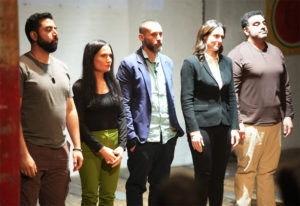
On a wet, snowy evening in Brooklyn, over one hundred people turned out for a reading of “How To Make A Revolution” at the Invisible Dog Art Center. The documentary play is co-authored by Israeli Jewish activist Einat Weizman and Palestinian human rights advocate Issa Amro, who lives in the West Bank.
I first heard Amro discussing living conditions under Israeli rule in the film “Tinderbox.” I wondered if he would make it to the United States for the event due to his November 22, 2022, arrest. He was there and spoke with audience members before and after the performance.
The text is based on transcripts from Amro’s trial at the Ofer military court and drills down on the reality of the proceedings, where no audio or visual recordings are allowed. There are no juries; the Palestinian conviction rate is 99.7 percent. Although deemed legal and official, they present as kangaroo courts, where outcomes are pre-determined. The use of official testimony, where absurdity meets Kafka, reveals sequestered realities to the outside world.
Empty chairs set the stage while images were projected on a white brick wall. One photograph showed a street demarcated by barbed wire. The James Brown song “I Feel Good” was in the background.
Intertwined with the re-enactment of the trial is a recreation of how the relationship between Weizman and Amro evolved, and the pressures they each faced in their respective spheres. The viewers comprehend that they, too, are part of the unfolding story — as they bear witness to the human rights injustices and impunity of ongoing Israeli structural oppression.
Weizman met Amro at his home in Hebron, entering through the settlement of Kiryat Arba. Derisive calls from its residents greeted her presence. “Are you leftist? Are you going to Issa?” They conclude their condemnations with a singular word: “Traitor.”
When Weizman told friends she was going to Hebron, they thought she was “nuts.” Other activists informed her that Amro was a “normalizer.” When performing this sequence, Weizman looks directly at the audience and asks if it’s her place “to tell a Palestinian how to resist.”
In Hebron, the marketplace is closed. Palestinians are not visible on the street. It wasn’t always like that. Now, if local community members want to pass, they need identification. Checkpoints separate Jews from Muslims. Detention at these stations can stretch to up to six hours.
One can only think of segregated America when Weizman delves into how different her relationship with Amro felt when they were in London for the Finborough Theatre’s digital presentation of the piece. Reflecting on the reality in Israel/Palestine, Weizman calls it the “hall of injustice” where Palestinians use one door and Jewish Israelis use another…a condensed scene of occupied and occupier.”
Amro’s personal history reveals how his consciousness emerged and developed. He had been at college to become an engineer when the IDF closed down the university he was attending. Angry and frustrated, he googled “How to make a revolution.” He learned about the strategies of Martin Luther King and Gandhi. The authorities reopened the school because of his specific efforts. Amro explains, “I got my degree, but I graduated as an activist.” He realized that he was able to effect change.
Ironically, Amro’s life is not only shaped by Israeli dictates (“I live under military law.”). The Palestinian Authority has arrested him at the directives of Israel. One minute they want Amro to join them; then they throw him in jail. His response was to go on a hunger strike. For twenty hours a day for six weeks, the PA questioned Amro. One of their top interests was, “How come you have so many supporters…including Bernie Sanders?”
At the conclusion of the reading, Tamer Nafar, as Amro declares, “I refuse to disappear.”
The actors then sat in total silence. You could hear a pin drop.
When Amro stepped forward to engage the crowd, he took questions and expanded upon the underpinnings of the narrative. After thanking people for coming, he clarified, “This play tells my story, but it is everyone’s story. I’m not special.”
Amro conveyed there were different methods for building awareness about the dire situation impacting daily life for Palestinians, from non-violent actions to using the arts to reach people on a visceral level. Amro reiterated his belief that the Israeli government wants to “kill the spirit of the Palestinians.”
“There is no Israeli democracy without an end to apartheid and occupation,” Amro said. While underscoring the muted response of Israelis to what is happening to Palestinians, he did see a shift, particularly among young Jewish activists. “More people are opening their eyes.”
Perhaps the top takeaway was Amro’s statement, “American Jews can make a difference.” He added, “I depend on your support. We all have a dream.”
How To Make a Revolution
Cast: Abraham Makany, Einat Weizman, Tamer Nafar, Fleece, Michael Elian
Photo: Courtesy Vlad Grinberg